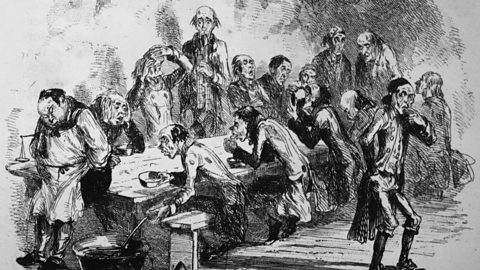Social injustice in a Christmas Carol
Dickens felt strongly that Victorian society ignored the poverty of its underclass. On the one hand were the rich who enjoyed comfort and feasting at Christmas, and on the other were children forced to live in dreadful conditions in workhouses.
Learn more about the social and historical context in this podcast
Listen to the full series on ґуПуґ«ГЅ Sounds.
How is the theme of social injustice shown in the novella?
In A Christmas Carol Dickens shows the theme of social injustice through:
- Scrooge refusing to give money to the poor
- the characters of Ignorance and Want
- thieves dividing up Scrooge's belongings
| How does Dickens show this? | Evidence | Analysis | |
| Scrooge refuses to give money | In Stave I Scrooge is asked to make a donation for the 'Poor and destitute' of society. | "The Treadmill and the Poor Law are in full vigour, then?" said Scrooge. | Scrooge's refusal represents the selfishness of the richer elements of Victorian society. Instead of creating a community in which life can be enjoyed by all, Dickens highlights the injustice of wealth distribution. |
| Ignorance and Want | Dickens uses two wretched children, called Ignorance and Want, to represent the poor. | a stale and shrivelled hand, like that of age, had pinched, and twisted them, and pulled them into shreds. | The children that hide under the robes of the Ghost of Christmas Present are 'pinched' and 'twisted' rather than being happy and joyous as we would like children to be. The Ghost tells Scrooge that the children are the responsibility of all mankind. |
| Thieves dividing up Scrooge's belongings | Dickens uses the thieves dividing up Scrooge's belongings to show how his death is received. | "Every person has a right to take care of themselves. He always did." | As the thieves sort through Scrooge's possessions they comment on how miserly he had been in life. This makes him, and the reader, appreciate the failings of only thinking of oneself. |
| Scrooge refuses to give money | |
|---|---|
| How does Dickens show this? | In Stave I Scrooge is asked to make a donation for the 'Poor and destitute' of society. |
| Evidence | "The Treadmill and the Poor Law are in full vigour, then?" said Scrooge. |
| Analysis | Scrooge's refusal represents the selfishness of the richer elements of Victorian society. Instead of creating a community in which life can be enjoyed by all, Dickens highlights the injustice of wealth distribution. |
| Ignorance and Want | |
|---|---|
| How does Dickens show this? | Dickens uses two wretched children, called Ignorance and Want, to represent the poor. |
| Evidence | a stale and shrivelled hand, like that of age, had pinched, and twisted them, and pulled them into shreds. |
| Analysis | The children that hide under the robes of the Ghost of Christmas Present are 'pinched' and 'twisted' rather than being happy and joyous as we would like children to be. The Ghost tells Scrooge that the children are the responsibility of all mankind. |
| Thieves dividing up Scrooge's belongings | |
|---|---|
| How does Dickens show this? | Dickens uses the thieves dividing up Scrooge's belongings to show how his death is received. |
| Evidence | "Every person has a right to take care of themselves. He always did." |
| Analysis | As the thieves sort through Scrooge's possessions they comment on how miserly he had been in life. This makes him, and the reader, appreciate the failings of only thinking of oneself. |
Social and historical context

The Poor Law was amended in 1834 to reduce the cost of helping the poor. Those desperate for assistance and having no other option were sent to workhouses.
The novella shows these contrasts by presenting poverty in the Cratchit household, in the characters of Ignorance and Want who are sheltered by the Ghost of Christmas Present and also in the scene of thieves going through the dead Scrooge's possessions.
Analysing the evidence
Question
What elements of social injustice does Dickens highlight in this novella?
- Scrooge insists that the Poor Law, prisons and workhouses should deal with the destitute.
- 'Ignorance' and 'Want' highlight the unfairness of Victorian society.
- The thieves show how people were driven to steal from the dead.